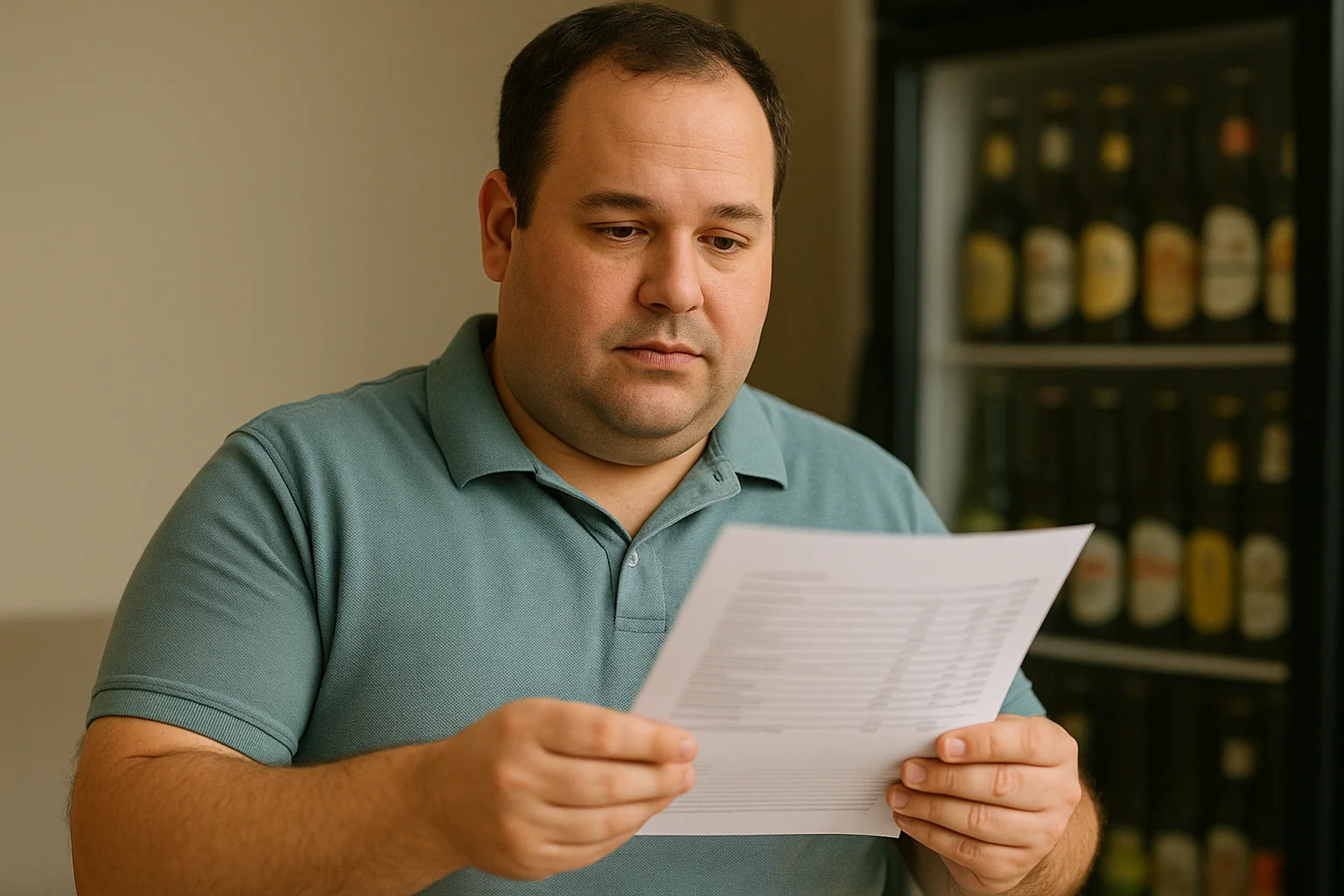A 2 minute assessment to get a personalized mental health or alcohol recovery plan.
Even moderate drinking can raise triglycerides, and heavier patterns can send them soaring to dangerous levels—but the good news is that triglycerides typically respond quickly when you cut back on alcohol.
What You'll Discover:
- Why alcohol raises triglycerides and the exact mechanism
- How much alcohol it takes to affect your numbers
- Who is most sensitive to alcohol's triglyceride effect
- When high triglycerides become a medical emergency
- A practical 4-week plan to lower your levels
- How naltrexone can help if cutting back is harder than expected
If your blood test showed high triglycerides, alcohol is one of the first habits your doctor will ask about. There's a clear reason: even "moderate" drinking can nudge triglycerides upward, and heavier or binge drinking patterns can send them soaring—sometimes to levels that raise the risk of acute pancreatitis, a painful and potentially life-threatening condition.
The first thing to know is this: triglycerides typically respond fast when you change what and how you drink. This guide gives you an easy explanation of what triglycerides are, exactly how alcohol pushes them higher, what amounts matter, who's most at risk, and a practical four-week plan to bring numbers down.
The Quick Answer
Yes, alcohol raises triglycerides. It delivers a burst of calories that your liver turns into VLDL (a triglyceride-rich particle), and it accelerates your liver's own fat production. The more you drink and the sweeter your mixers, the higher the spike.
Cutting back often lowers triglycerides within 4-12 weeks, especially when combined with dietary changes and regular movement.
What Triglycerides Are and Why Your Doctor Cares
Triglycerides are the storage form of fat that circulates in your blood. Think of them as "energy on delivery." After you eat or drink, your body packages excess calories—from sugar, starch, fat, and alcohol—into triglyceride-rich particles that travel through your bloodstream.
Chronically high levels are linked with atherosclerotic cardiovascular disease. At very high levels, typically 500-1,000 mg/dL or higher, triglycerides are linked with acute pancreatitis. The American Heart Association considers a normal level to be less than 150 mg/dL.
So when your doctor sees elevated triglycerides on your blood work, they're not just concerned about a single number—they're seeing a marker of metabolic stress and potential cardiovascular risk.
Why Alcohol Raises Triglycerides: The Simple Mechanism
Understanding how alcohol affects triglycerides helps you see why cutting back makes such a difference.
Step 1: Alcohol Goes to the Liver First
When you drink, alcohol goes directly to your liver, where it takes priority over everything else. Your liver essentially says "deal with this ethanol first" and temporarily shuts down fat burning to focus on processing the alcohol.
Step 2: The Liver Turns Alcohol Into Fat
As your liver metabolizes alcohol, it produces substances that the liver readily channels into making new fatty acids—a process called de novo lipogenesis. Your liver then packages these fats as VLDL (very low-density lipoprotein), which increases blood triglycerides.
Step 3: Alcohol Plus Carbs Amplifies the Effect
Sugary mixers, beer with its malt sugars, or that late-night pizza create a double hit. You're giving your liver more substrate for fat-making, plus alcohol that tells it to store everything as fat. This combination is particularly powerful at raising triglycerides.
Step 4: Regular Drinking Creates a New Baseline
Over time, regular drinking trains your liver to stay in fat-export mode, sustaining higher fasting triglycerides even when you're not actively drinking.
This is why clinical guidance for high triglycerides starts with limiting or eliminating alcohol.
How Much Alcohol Changes Your Numbers?
Everyone's biology is different, but there are patterns clinicians see repeatedly.
Occasional, small amounts—like a single standard drink with a meal—typically cause small, short-lived rises in triglycerides that your body clears relatively quickly.
Daily or moderate drinking—one to two drinks most days—can nudge fasting triglyceride levels upward over time, especially if your diet is high in refined carbs or sugary mixers.
Binge drinking—four or more drinks for women, five or more for men in about two hours—can cause sharp post-drinking spikes. If your triglycerides are already elevated, binge drinking can push them into ranges that risk pancreatitis.
Very high baseline triglycerides—if your fasting triglycerides are above 500 mg/dL, most lipid guidelines advise abstaining completely from alcohol until levels improve. At these levels, even small amounts can trigger dangerous increases.
A standard drink in the United States contains 14 grams of pure alcohol—that's 12 ounces of beer at 5% ABV, 5 ounces of wine at 12% ABV, or 1.5 ounces of distilled spirits at 40% ABV.
Who Is Most Sensitive to Alcohol's Triglyceride Effect?
Some people are more vulnerable to alcohol's impact on triglycerides.
People with high-carb or high-sugar diets see amplified effects because alcohol plus sugar supercharges triglyceride production in the liver.
Anyone with insulin resistance, prediabetes, or type 2 diabetes has a liver that's already primed to make more fat. Alcohol piles on top of that existing problem.
People with genetic lipid disorders, such as familial hypertriglyceridemia, are particularly sensitive to any dietary or lifestyle factor that raises triglycerides.
Those with very high baseline triglycerides above 500 mg/dL find that even one or two drinks can be too much.
People with fatty liver disease face a double problem—alcohol can worsen both hepatic fat accumulation and VLDL export, creating a vicious cycle.
For more background on high triglycerides and common causes including alcohol, the National Institute of Diabetes and Digestive and Kidney Diseases has a helpful overview.
"But I Heard Moderate Alcohol Can Help Cholesterol?"
You may have seen headlines suggesting that moderate alcohol raises HDL, the "good" cholesterol. While this is sometimes true, it doesn't neutralize the triglyceride problem—especially when lowering triglycerides is your priority.
When triglycerides are high, the safest and most guideline-consistent message is clear: cut alcohol, ideally to zero at first, then reassess your numbers with your doctor.
The Real Pancreatitis Risk with Very High Triglycerides
Once triglycerides soar into very high ranges, your pancreas is at risk. Hypertriglyceridemia is a recognized cause of acute pancreatitis, and alcohol can be the trigger that pushes levels into the danger zone.
Clinicians become very cautious when fasting triglycerides approach 500-1,000 mg/dL, and urgent when they exceed 1,000 mg/dL. At these levels, the risk of acute pancreatitis increases significantly.
If you have abdominal pain after heavy drinking—especially if you know you have very high triglycerides—seek urgent medical care immediately.
Mixers, Timing, and Hidden Alcohol Effects That Matter
The details of how you drink affect your triglyceride response more than most people realize.
Sweetened mixers like juice, regular soda, and simple syrup add a rapid glucose and fructose load that feeds liver fat production. Choosing seltzer or diet mixers reduces this effect.
Beer adds malt sugars on top of the alcohol, compounding the triglyceride-raising effect more than an equivalent amount of straight spirits.
Late-night eating after drinking leads to bigger next-morning triglycerides because your liver continues making and exporting fat while you sleep.
Weekend patterns count more than you think. Back-to-back "only on weekends" binges can keep triglycerides elevated well into the following week.
How Quickly Can Triglycerides Improve?
Here's the encouraging news: fasting triglycerides can start improving within 4-12 weeks of sustained lifestyle changes. Many people see a meaningful drop by their next lipid panel if they reduce or stop alcohol, cut refined sugars, and add daily movement.
Your doctor will typically recheck your levels 6-12 weeks after you make changes to see how you're responding.
A Practical Four-Week Plan to Lower Triglycerides
This plan is designed to be realistic and sustainable, not restrictive to the point where you can't maintain it.
Week 1: Baseline and Quick Wins
Log your current drinking pattern for seven days. Write down what you drink, how much, when, what mixers you use, and what you eat after drinking. This awareness alone often changes behavior.
Swap mixers to seltzer, diet soda, or zero-sugar tonics if you continue drinking at all. Institute "no-drink nights" for at least three nights per week. Stack them together if weekends are your high-risk window.
Add a 10-20 minute walk after your biggest meal. Movement helps clear triglyceride-rich particles from your bloodstream.
Week 2: Cut the Main Driver
Pick your maximum and stick to it—for example, no more than one standard drink on any single day this week. If your last fasting triglyceride reading was 500 mg/dL or higher, aim for zero drinks this week.
Front-load protein and fiber when you socialize. Eat grilled chicken and vegetables before events where alcohol will be available. This helps stabilize blood sugar and reduces the metabolic impact of any alcohol you do consume.
Time-box your evenings. Late-night eating combined with alcohol is triglycerides' best friend. Set a cutoff time for both.
Week 3: Replace the Habit, Not Just the Drink
Create a default plan for your trigger moments. Stock sparkling water with citrus, non-alcoholic beer, or herbal tea you actually enjoy. The key is having an alternative you like, not just white-knuckling through cravings.
Schedule early-morning plans like a gym class, hike, or friend workout that make late drinking inconvenient. You're less likely to drink heavily the night before if you've committed to something you care about the next morning.
Track how you feel on no-alcohol mornings versus after drinking nights. Notice the difference in energy levels, mood, and cravings. This awareness builds motivation.
Week 4: Lock In and Get Data
If your baseline triglycerides were high, ask your clinician about rechecking a fasting lipid panel. Seeing the numbers improve is powerful reinforcement.
If cutting back is harder than expected because of cravings or momentum loss, consider medication-assisted support. Naltrexone is one FDA-approved option that can make reducing drinking much easier, and we'll discuss it more below.
Food, Weight, and Movement Amplify Alcohol's Impact
Alcohol doesn't work in isolation. These three factors either amplify or mitigate its effect on triglycerides.
Carbs and sugars: Lowering added sugar, refined grains, and liquid sugars like juice and soda reduces the substrate your liver converts to triglycerides. This is especially powerful when combined with reduced alcohol intake.
Weight: Even 5-10% weight loss can substantially lower triglycerides for many people. The combination of weight loss and alcohol reduction is particularly effective.
Movement: Brisk walks, cycling, swimming—any daily aerobic activity—helps your muscles burn circulating triglycerides and improves insulin sensitivity, both of which lower triglyceride levels.
For more on how alcohol drives abdominal fat accumulation and stalls fat-burning, read our guides on why an alcohol belly isn't just about beer and how drinking beer sabotages weight loss.
When to Consider Zero Alcohol (At Least for Now)
In some situations, complete abstinence from alcohol is the safest medical recommendation, at least until your numbers improve.
Consider zero alcohol if your fasting triglycerides are 500 mg/dL or higher (and certainly if they're 1,000 mg/dL or above), if you have a history of pancreatitis, if you have diabetes with poor blood sugar control, if you have fatty liver disease, or if you've tried cutting back but it doesn't stick.
In these situations, most clinicians will recommend abstinence until your numbers are consistently improved. They may also prescribe triglyceride-lowering medications alongside lifestyle changes.
What About Different Types of Alcohol?
It's less about whether you choose beer, wine, or spirits, and more about dose plus sugar content.
Beer contains alcohol plus malt sugars, giving it more triglyceride-raising potential per serving than straight spirits.
Sweet wines, liqueurs, and cocktails with sugar syrups or juice mixers combine alcohol and sugar in a way that strongly drives triglycerides up.
Straight spirits deliver the same ethanol load per standard drink but have fewer carbs if you drink them neat or on ice. However, don't mistake "zero carb" for "zero triglyceride impact"—the alcohol itself still raises triglycerides.
Are There Supplements That Lower Triglycerides?
Some omega-3 formulations (EPA and DHA) can lower triglycerides, often used at 2-4 grams per day under a clinician's guidance. However, supplements won't neutralize alcohol's effect if drinking continues.
When triglycerides are very high, clinicians emphasize alcohol restriction first, then add prescription-strength omega-3, fibrates, or other medications when appropriate.
How Clinicians Approach This in Practice
Doctors typically follow a stepwise approach for managing high triglycerides.
First, they recommend lifestyle changes: limit or stop alcohol, reduce sugars and refined carbs, and increase daily movement. Then they recheck your levels in 6-12 weeks.
If triglycerides remain high after lifestyle changes, they add medications like omega-3 ethyl esters, fibrates, or sometimes statins if LDL cholesterol or cardiovascular risk is also elevated.
For very high triglycerides or pancreatitis risk, the approach is more aggressive: no alcohol, strict carbohydrate control, intensive triglyceride-lowering therapy, and close monitoring.
Common Questions About Alcohol and Triglycerides
"If I only drink on weekends, is that okay for triglycerides?"
Two nights of heavy drinking can keep triglycerides elevated well into the following week. If your triglycerides are high, try four alcohol-free weeks and retest to see the impact.
"Is red wine better than other types of alcohol?"
Some studies suggest modest HDL increases with wine, but when triglycerides are your concern, the ethanol itself is the problem regardless of the source. Treat wine like any other alcohol.
"My triglycerides are normal—can I ignore this?"
If your triglycerides are consistently below 150 mg/dL, your overall risk is lower. However, if your drinking pattern includes binges, you can still experience post-drinking spikes that stress your system. If your doctor flags rising triglycerides or other risk factors like insulin resistance or fatty liver, reassess your alcohol habits.
"How do I measure a standard drink at home?"
Use measured pours for the next few weeks: 12 ounces of beer at 5% ABV, 5 ounces of wine at 12% ABV, or 1.5 ounces of 80-proof spirits. The CDC has helpful visuals showing what standard drinks look like.
Quick Safety Notes
Very high triglycerides (500-1,000 mg/dL or higher) combined with any drinking is a red flag. Talk to your clinician about abstinence and treatment options immediately.
New abdominal pain after heavy drinking could be pancreatitis—seek urgent medical care.
If you take prescription medications for diabetes, blood thinners, or lipid control, ask your clinician or pharmacist about alcohol interactions.
Where Medication Support Fits
If cravings or momentum are the main barriers to cutting back, medication-assisted treatment can help you drink less more consistently, which in turn helps your triglycerides.
Naltrexone is an FDA-approved medication for alcohol use disorder that reduces the rewarding effects of alcohol, making it easier to stop at one drink or skip drinking entirely. Large reviews show it reduces heavy drinking days with clinically meaningful effects compared to placebo.
Choose Your Horizon runs a fully virtual naltrexone program: a quick medical consultation, at-home medication delivery, and ongoing support through AI coaching and weekly groups. Many people use it with goals ranging from "just weekends" to "abstinent for now," and triglyceride improvements often follow when alcohol consumption goes down.
If you're curious whether this approach fits your situation, take our brief, judgment-free assessment to understand your options and see if naltrexone is a safe match for you right now.
Start your confidential assessment
Bringing It All Together
Alcohol raises triglycerides through liver fat production and VLDL export, and the effect is magnified by sugary carbs and late-night eating. For many people, four weeks of cutting alcohol plus sugar, moving more, and making simple meal adjustments will drop triglycerides meaningfully.
If you've tried to cut back but the habit keeps snapping back despite your best intentions, don't try to white-knuckle it. Use evidence-based tools that improve your odds of success—whether that's naltrexone, coaching, or both.
Your triglycerides can improve. The steps are clear, the timeline is relatively short, and the health benefits extend far beyond a single number on a lab report.




